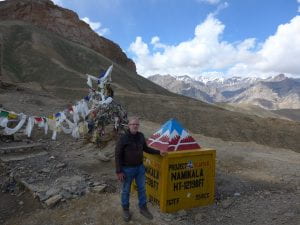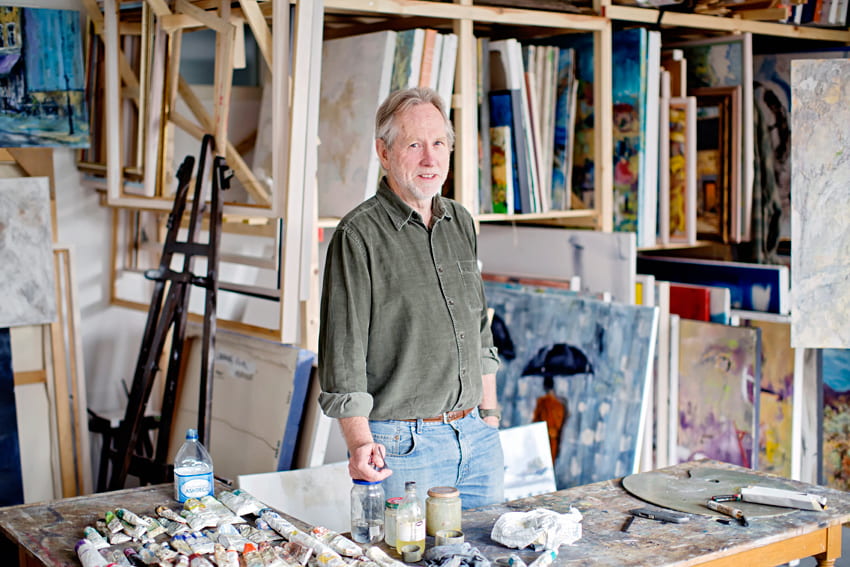Meet Graham McBride, well-travelled artist and judge on the Rural Crime and Law Photo Competition. Graham is lending his expertise and keen understanding of life in rural Australia to the competition, and he was nice enough to tell us his story.
The traveller and his passion
Graham’s career and the path that led him to where he is today has not been a straight line, but it has given him many excellent experiences. Being born in Cairns, raised in western Queensland, then living in Glen Innes and eventually Mackay – it is no wonder that Graham had developed a sense of wanderlust from a young age. He says his “restlessness won out” when he was 20, leading him to travel to Perth and backpack through Java, Sumatra, Thailand and Cambodia.
Having gathered a wealth of worldly experience, Graham eventually returned to Australia where he began studying an Environmental Science degree at Griffith University. This was followed by postgraduate studies at Sydney University, which led him to co-found a technology company and relocate to the UK in 1990. Throughout his education and ensuing career Graham always had a strong artistic side – in recent years he has fully embraced his passion and decided to become a fulltime artist.
With a sketchbook in his pocket, Graham cherishes his trips to France with friends and motorcycling to new and different locales. For Graham, inspiration is around every corner.
The meaning of place
The Rural Crime and Law Photo Competition is as much about rural places as much as it is about crime. For Graham, some distinct memories of place have particularly inspired his art:
“Bukittinggi in Sumatra: always a place that comes to mind, staying with a family in this matrilineal society where the rain tumbled down every afternoon, seeming to create it anew. Life of the town had different characteristics before, during and after the rain. I was deeply affected by the different private/family space/public spaces and how the nature and shape of the boundaries changed and differed depending on the physical conditions and the various cultural and racial groups.”
“Takayama Japan: visiting a craft market along the river, it being so quiet I found myself whispering as if in reverence to the quality of the work and the space. I felt the sense of place existed at different scales, like a nested concept of individual craft pieces in a long space bordered by a swiftly flowing stream and high mountains. Each space seems to have its own character and I was intrigued by how it affected the way we express ourselves.”
It is this keen eye and artistic passion that makes Graham a perfect judge for the Rural Crime and Law Photo Competition.
Fostering engagement
The art of capturing a moment, whether through the lens of a camera or through the bristles of a brush, is coloured by passion and interpretation. Graham says one of the most rewarding parts of being a judge on the photo competition will be seeing how entrants have transferred their feelings and understandings of rural crime into a photograph.
Graham’s childhood in rural Australia was another motivation for becoming a judge on the competition: “I grew up in a rural area and love the feel of the Australian country and have a lot of empathy and emotional attachment to the particularities of rural life. I was attracted to the concept of a photo competition because it’s an avenue for individuals to present their concerns and viewpoint.”
“More than that, the planned public showing of the images can help to legitimise and foster community engagement and get people talking about rural crime.”
Drawing on his familiarity with regional Australia, Graham noted that it is important to challenge rural crime and portray its destructive nature in all its forms. However, he also recognises that there is often a reticence to discuss crime in rural settings.
“There is a sensitivity to being singled out as a ‘victim’,” said Graham. “A reluctance to report is often, in my experience, brushed away by the cultural reticence in something perceived as being ‘not my place’. With the general low population and density in rural areas, there is a belief in not having much influence or power. If they highlight it, the feeling is it will more than likely be overlooked or ignored.”
“I think rural crime can be insidious, eating away at community’s cohesion and trust. We need to swap the polarities. I believe the culture of being quiet is more harmful than speaking out.” As Graham pointed out, one of the competition’s benefits will be that it will create a conversation and engagement through the lens of camera – capturing what needs to be said.
Visualising rural crime
As an artist at heart, Graham has some thoughts on the subject of visualising rural crime:
“Complex isn’t it? While much of the crime occurring probably is the same in urban as in rural areas, I have a vision of it often occurring under the radar. I see crime worm holing its way through rural locations, eroding the values of a sense of community. I see harm being internalised and maybe divulged only in quiet conversation – if at all. I visualise people being taken advantage of, of isolation and private troubles. More overtly I see loss of critical equipment that enables livelihood; the stealing of stock; the decay of drugs that infiltrate into the communities.
“It’s not all because of crime of course, but crime can come about via lack of options, poverty, low education … all this stuff … perhaps we will see something of the causes of crime coming up in the competition. On a more positive note, I also see the strength of people standing up to it.”
Graham believes it’s also important not to forget often overlooked environmental and cultural crime, such as “crime against Indigenous cultural capital”.
“I am concerned about how the culture – or feeling – of a space and place people live in can so easily fracture when key aspects – familiar aspects such as altering landscape – are taken away.”
If you would like to take part in the Rural Crime and Law Photo Competition, all submissions are encouraged and welcomed. Entries close Friday 22 April. For more information about the competition and how to enter, follow the link here.

Graham McBride is inspired by his travels.



Recent Comments